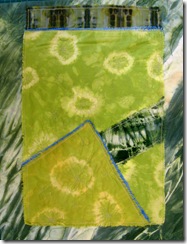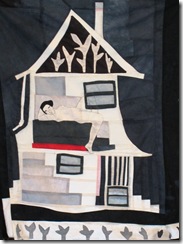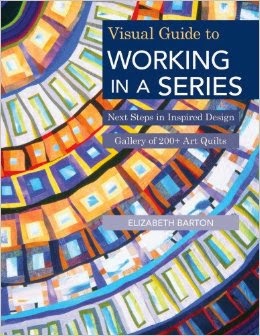I don’t know about you but I worry that my quilts might be boring. I know by the time I’m done fussing over them, I’m often very tired of them. So often ,when I look at the finished work instead of seeing all the elusive moods, sensibilities and nuances that were in my head at the start of the piece, I see the tussles I had!
I usually just have to put the quilt away for a few months like a cheese and hope that it improves as it matures! I used to think that this happened because I was just a beginning artist, but the more I read the more I see that even experienced artists struggle with these same things.
So I’m always interested in learning about ways to improve a piece, especially ways to make it more interesting. When I look at quilts online and in print, I see two things that I want to avoid. One is work I can make no sense of, work that looks like my nephew’s basement pad! He can make sense of it, but I can’t and I have to retreat Very Quickly! The other thing, which is probably worse because it leads to me moving on even more quickly than a chaotic mess, is work that is totally boring, dull, torpid, predictable, pedestrian, dreary, dry, dull, humdrum, monotonous, stuffy and tedious! Like this sentence.
So, what makes an art quilt boring? We know from old wartime psychological studies on habituation, that if things are very predictable, after a while we just don’t see them. They don’t attract our attention. Or, in musical terms, a steady dull beat ( like in those 60s pop songs that some of us whose husbands never grew beyond the stage have to put up with!) can lead to a pretty melody withering on the vine. (Oh, love those mixed metaphors!) No synocopation, no alternating rhythms, no two hands playing to a different time lead to unobserved tedium.
In visual terms, shapes are boring that repeat in a dull 4/4 time – equally sized and equally shaped, and, what’s more, with equal negative spaces between them. Although we’re not initially aware of the negative spaces in a piece (the space between the edges of things…within and without shapes, or between a shape and the edge of the quilt), it is often an interesting negative space, or the rhythm of such spaces that support the work and keep you involved with it and attracted to it.
Let’s look at quilts where I think I was able to create some rhythms in the spaces.
Between the rooflines and the top edge of the quilt is a negative space. Each side is different – one has 4 steps to descend, one has two – I could have balanced the steps on each side and lined up the places where the steps occur but that would have been less interesting. I’ve repeated the same idea at the bottom of the quilt – with one side having more steps away from the bottom edge than the other, and each of the steps being slightly different.
Petergate
In Aorist, a small piece I made for the Kiss Challenge that Rachel Roggel organized years and years ago (and I’ve no idea where this quilt is now), I made the negative spaces create the meaning of the piece. Of course I was playing on the idea of the old image of two faces vs a vase that you see in psych textbooks! But I put a little different rhythm on the left side from the right to make it more interesting.
In Assembly, I wanted to create an intriguing negative space for the sky area, but I also wanted to repeat that idea (with somewhat different rhythms) within the larger shapes lower in the quilt. I also played with the negative and positive shapes changing places at times!
In Oh What Pretty Smoke, there are a lot of vertical elements which are similar in shape..so in order to make it more interesting, I varied the width of each shape, and the height, and the spaces between the shapes, and the surface texture of the shapes…while at the same time holding the idea of the shape constant so that you know they are related to one another. That they belong in the same song.
I usually block out my quilts on the design wall before sewing them together, and in my last evaluation check before stitching, I check the spaces between and within the shapes, and between the main shapes and the 4 straight edges of the quilt. Looking at the quilt above, I think it would have been good to have had a little more space on one of the sides, to emphasize the difference…I’ll try to remember for next time!
If you have been, thanks for reading! And do please comment….also I must apologize for somewhat long negative spaces between posts this summer – too much travelling! and I have one more long trip to go: to England for the Festival of Quilts next month where I’ll be showing Oh What Pretty Smoke and about eleven other quilts based on industrial landscapes.
I look forward to hearing from you!! and maybe even meeting some of you at FOQ. Elizabeth






































